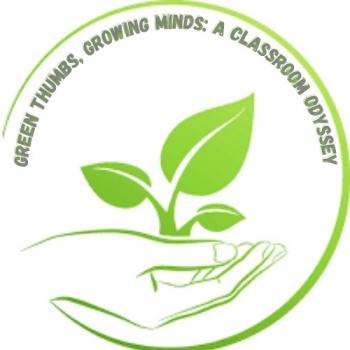"Green Thumbs, Growing Minds: A Classroom Odyssey"

- School:
- Walton Academy
- Subject:
- STEM Education
- Teacher:
- Carolyn Moussa
- Students Impacted:
- 175
- Grade:
- 9-12
- Date:
- October 5, 2023
Investor
Thank you to the following investor for funding this grant.
Florida Power & Light - $1,000.00
Original Grant Overview
Goal
Goal: Transforming a Little Patch into a World of Wonders
We aim to convert a modest patch of land adjacent to our learning space into an interactive garden. This garden will serve as a hands-on educational tool, allowing students to delve into the world of plants, witness the magic of growth, and learn foundational scientific and mathematical concepts in a tangible manner. Adjacent to this budding learning space, a tribute tree stands, symbolizing shared stories and memories. With this initiative, we're not just growing plants; we're cultivating curiosity, nurturing young minds, and strengthening community bonds.
What will be done with my students
1. Planting & Nurturing: Students will have firsthand experience with the complete lifecycle of plants. They'll begin by planting seeds and seedlings in the garden beds and will learn about the requirements of different plants.
2. Scientific Exploration: Our young gardeners will conduct experiments to understand how different factors, like sunlight, water, and soil quality, affect plant growth. They'll learn about photosynthesis, the importance of pollinators, and the role of different nutrients in the soil.
3. Math in Nature: By measuring plant growth, counting leaves or flowers, and tracking growth over time, students will apply mathematical concepts such as measurement, percentages (like growth rate), and patterns.
4. Journaling & Reflection: Each student will maintain a garden journal. This will include their observations, sketches of the plants at different stages, and their personal reflections on the growth process and what they're learning.
5. Collaborative Projects: Students will work in teams to tackle certain garden tasks, promoting teamwork, responsibility, and collaboration. This might include setting up a watering schedule, ensuring plants are pest-free, or even organizing a small "harvest day" when the time comes.
6. Tribute Tree Connection: Students will learn about the significance of the tribute tree and will have sessions where they reflect on its meaning, possibly leading to projects where they explore the stories and histories connected to it.
7. Presentation & Sharing: At the end of the season or school year, students will have an opportunity to present what they've learned and share their experiences with their peers or even the broader school community.
Through these activities, the garden will become more than just a patch of earth—it'll be a living classroom where lessons come alive, where responsibility is cultivated, and where the magic of nature underscores everyday learning.
Planned Timeline for Implementation (November 2023 - May 2024):
1. Week 1 (November 1st - 7th): Upon grant approval, finalize garden design details, and order necessary supplies.
2. Week 2-3 (November 8th - 21st): Prepare the designated garden area, and set up raised beds. Host an introductory session for students to familiarize them with the garden project.
3. Week 4 (November 22nd - 30th): Begin planting, focusing on crops suitable for the season, if applicable. Initial lessons on basic plant life and care.
4. Week 5-8 (December 1st - 18th): Maintenance of the garden, student journaling, and observational activities. Introduce foundational mathematical concepts related to the garden.
5. Week 9-12 (January 1st - 21st, 2024): Resume after winter break. Lessons on photosynthesis, plant biology, and sustainability. Continued maintenance and care of the garden.
6. Week 13-16 (January 22nd - February 12th): Integration of "Leader in Me" principles with gardening tasks. Start preparations for potential early spring harvest, if applicable.
7.Week 17-20 (February 13th - March 6th): Harvest and nutrition lessons. Emphasize "Leader in Me" principles, focusing on teamwork, responsibility, and proactive planning in the garden.
8. Week 21-24 (March 7th - 28th): Reflections on the gardening experience, preparation of presentations, and sharing of journals.
9.Week 25-28 (March 29th - April 19th): Student presentations and discussions. Begin preparations for transitioning the garden for late spring and early summer crops.
10. Week 29-32 (April 20th - May 12th): Planting for late spring and early summer. Emphasis on maintaining the garden and ensuring its sustainability.
11. Week 33-36 (May 13th - 29th): Final reflections, lessons, and preparations for summer. Discuss potential summer maintenance plans and the future of the garden in the next academic year.
Benefits to my students
1. Hands-on Learning: The garden will serve as an interactive classroom, enabling students to understand concepts not just theoretically but through tangible experiences. This enhances retention and deepens comprehension.
2. Cultivation of Responsibility: By taking care of plants and ensuring their growth, students learn about responsibility, patience, and the consequences of their actions (or inactions).
3. Teamwork and Collaboration: Group activities in the garden promote teamwork. Students will learn to communicate effectively, delegate tasks, and work cohesively towards a common goal.
4. Connection with Nature: In an increasingly digital age, the garden offers students a chance to reconnect with nature, understand ecosystems, and appreciate the beauty and intricacies of the natural world.
5. Emotional Well-being: Gardening has therapeutic effects. The act of nurturing plants can help reduce stress, improve mood, and boost overall well-being. The garden becomes a space of solace and reflection.
6. Critical Thinking and Problem Solving: Encountering challenges such as pests, plant diseases, or unpredictable weather will require students to think critically, innovate, and come up with solutions.
7. Enhanced Creativity: Keeping journals, observing plant growth, and understanding the beauty in nature can inspire artistic endeavors, be it through drawing, writing, or even photography.
8. Understanding of Nutrition and Sustainability: As they grow edible plants, students can learn about nutrition, the value of organic farming, and the importance of sustainable practices for the well-being of our planet.
9. Building Respect and Empathy: As students witness the life cycle of plants and the effort required to nurture them, they develop a deeper respect for nature and an empathetic understanding of the work that goes into producing the food they consume.
10. Cultural and Historical Connection: The tribute tree provides a direct link to shared stories and memories, teaching students the value of history, legacy, and community bonds.
Number of Students Benefiting:
Approximately 600 students will benefit from the "Cultivating Hope" garden initiative. This isn't limited to those who directly engage in gardening activities. The garden will serve as a communal educational hub for the entire student body:
1. Direct Engagement: Students who directly participate in planting, maintaining, and harvesting will gain hands-on experience, deriving firsthand lessons from the garden.
2. Educational Visits: Different classes or grade levels can visit the garden for tailored lessons, ranging from basic plant biology for younger students to more complex ecological studies for older students.
3. Shared Learning: Those who are directly involved can share their learnings, and experiences, and produce (if any) with their peers, creating a ripple effect of knowledge.
4. Events and Celebrations: The garden could serve as a venue for seasonal events, harvest celebrations, or even art showcases, allowing the broader student body to engage with and appreciate the space.
5. Tribute Tree Reflections: All students can engage with the tribute tree, using it as a point of reflection, understanding, and connection to shared histories and community values.
Budget Narrative
Budget Narrative:
1. Raised Garden Beds ($300):
Description: These are foundational for our garden project. Raised beds offer advantages like improved soil quality, better drainage, and ease of access for students.
Calculation: 2 units at 2 x 8 ft each priced at $150 per unit.
2. Soil & Organic Compost ($650):
Description: Quality soil and compost are critical for the healthy growth of plants. This mix provides the necessary nutrients, ensuring that plants thrive and that students can observe noticeable growth and health in the plants they tend.
Calculation: Approximately 65 cubic feet are needed, budgeted based on market rates and vendor quotations.
3. Commemorative Plaque for the Tribute Tree ($50):
Description: The plaque is essential to highlight the significance of the tribute tree, ensuring that all students, staff, and visitors understand its historical and sentimental value to the community. It provides context and deepens the tree's impact as an emblem of shared stories and memories.
Calculation: A basic engraved plaque, priced based on local suppliers' quotes.
Total Budget: $1,000
This budget is designed to maximize the educational impact of the garden while adhering to financial constraints. Each item is chosen not just for its direct utility but for the broader educational and emotional value it brings to the project.
Items
| # | Item | Cost |
|---|---|---|
| 1 | Raised Garden Beds (2 units at 2 x 8 ft each) | $300.00 |
| 2 | Soil & Organic Compost (approx. 65 cubic feet) | $650.00 |
| 3 | Commemorative Plaque for the Tribute Tree: | $50.00 |
| Total: | $1,000.00 |





Share
Please share this page to help in fulfilling this grant.
Email to a Friend